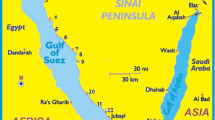Abstract
Cell volumes of phytoplankton collected from 12 different stations distributed in western and central Indian Sundarbans were estimated through calculation of similar type of geometric models. 12 geometric shapes have been assigned to calculate the cell volume of 47 phytoplankton species documented during the study period. The cell volume of the observed species was more in the western sector (112.89–269383.60 μm3) compared to the central sector (108.37–225131.20 μm3). Among 47 species recorded during December 2011, cell volumes of 6 species exhibited significant inverse relationships, and 2 species exhibited significant positive relationships with aquatic salinity. Our results suggest that cell volume of certain phytoplankton species can be used as indicator of aquatic salinity.


Similar content being viewed by others
References
Malone TC (1980) Algal size. In: Morris I (ed) The physiological ecology of phytoplankton. University of California Press, California, pp 433–463
Sournia A (1981) Morphological base of competition and succession. Can Bull Fish Aquat Sci 210:339–346
Chisholm SW (1992) Phytoplankton size. In: Falkowski PG, Woodhead AD (eds) Primary productivity and biogeochemical cycles in the sea. Plenum Press, New York, pp 213–237
Hastings JW, Sweeney BM, Mullin MM (1962) Counting and sizing of unicellular marine organisms. Ann N Y Acad Sci 99:180–289
Maloney TE, Donovan EJ Jr, Robinson EL (1962) Determination of numbers and sizes of algal cells with an electronic particle counter. Phycologia 2:1–8
Boyd CM, Johnson CW (1995) Precision of size determination of resistive electronic particle counters. J Plankton Res 17:41–58
Gordon R (1974) A tutorial on ART (algebraic reconstruction techniques). IEEE Trans Nucl Sci 2:78–93
Krambeck C, Krambeck HJ, Overbeck J (1981) Microcomputer-assisted biomass determination of plankton bacteria on scanning electron micrographs. Appl Environ Microbiol 42:142–149
Estep KW, MacIntyre F, Hjorleifsson E, Sieburth JM (1986) MacImage: a user friendly image-analysis system for the accurate mensuration of marine organisms. Mar Ecol Prog Ser 33:243–253
Verity PG, Sieracki ME (1993) Use of color image analysis and epifluorescence microscopy to measure plankton biomass. In: Kemp PF, Sherr BF, Sherr EB, Cole JJ (eds) Handbook of methods in aquatic microbial ecology. Lewis Publishers, Boca Raton, pp 327–338
Sieracki CK, Sieracki ME, Yentsch CM (1998) An imaging-flow system for automated analysis for marine microplankton. Mar Ecol Prog Ser 168:285–296
Olson RJ, Vaulot D, Chisholm SW (1985) Marine phytoplankton distributions measured using shipboard flow cytometry. Deep-Sea Res 32:1273–1280
Wood AM, Horan PK, Muirhead K, Phinney DA, Yentsch CM, Waterbury JB (1985) Discrimination between pigment types of marine Synechococcus spp. by scanning spectroscopy, epifluorescence microscopy, and flow cytometry. Limnol Oceanogr 30:1303–1315
Steen HB (1990) Characters of flow cytometers. In: Melamed MR, Lindmo T, Mendelsohn ML (eds) Flow cytometry and sorting, 2nd edn. Wiley-Liss, New York, pp 11–25
Cunningham A, Buonnacorsi CA (1992) Narrow-angle forward light scattering from individual algal cells: implications for size and shape discrimination in flow cytometry. J Plankton Res 14:223–234
Brown LM, Gargantini I, Brown DJ, Atkinson HJ, Govindarajan J, Vanlerberghe GC (1989) Computer-based image analysis for the automated counting and morphological description of microalgae in culture. J Appl Phycol 1:211–225
Mitra A, Banerjee K, Gangopadhayay A (2004) Introduction to marine phytoplankton. Daya Publishing House, Delhi, p 102
Banerjee K, Senthilkumar B, Purvaja R, Ramesh R (2012) Sedimentation and trace metal distribution n selected locations of Sundarbans mangroves and Hooghly estuary Northeast coast of India. Environ Geochem Health 34(1):27–42
Mitra A, Gangopadhyay A, Dube A, Schmidt ACK, Banerjee K (2009) Observed changes in water mass properties in the Indian Sundarbans (northwestern Bay of Bengal) during 1980–2007. Curr Sci 97(10):1445–1452
Chaudhuri AB, Choudhury A (1994) Mangroves of the Sundarbans, India. vol 1. IUCN, Bangkok, Thailand
Mitra A, Chowdhury R, Banerjee K (2012) Concentrations of some heavy metals in commercially important finfish and shellfish of the river Ganga. Environ Monit Assess 184:2219–2230
Verlencar XN, Desai S (2004) Phytoplankton identification manual, 1st edn. National Institute of Oceanography, Dona Paula
Botes L (2003), Phytoplankton identification catalogue, Saldanha Bay, South Africa (GloBallast Monograph Series No. 7, IMO, London)
Sun J, Liu DY (2003) Geometric models for calculating cell biovolume and surface area for phytoplankton. J Plankton Res 25:1331–1346
Raha A, Das S, Banerjee K, Mitra A (2012) Climate change impacts on Indian Sundarbans: a time series analysis. Biodiversity Conserv 21(5):1924–2008. doi:10.1007/s10531-012-0260-z
Hildebrand M, York E, Kelz JI, Davis AK, Frigeri LG, Allison DP, Doktycz MJ (2006) Nanoscale control of silica morphology and three-dimensional structure during diatom cell wall formation. J Mat Res 21:2689–2698
Roubeix V, Lancelot C (2008) Effect of salinity on growth, cell size and silicification of an euryhaline freshwater diatom: cyclotella meneghiniana Kutz. Transit Waters Bull 1:31–38
Pickett-Heaps JD, Schmidt AMM, Edgar LA (1990) The cell biology of diatom value formation. Prog Phycol Res 7:1–168
Harold F (2002) Force and compliance: rethinking morphogenesis in walled cells. Fungal Genetic Biol 37:271–282
Hazra S, Ghosh T, Dasgupta R, Sen G (2002) Sea level and associated changes in Sundarbans. Sci Cult 68:309–321
Author information
Authors and Affiliations
Corresponding author
Rights and permissions
About this article
Cite this article
Mitra, A., Zaman, S., Ray, S.K. et al. Inter-relationship Between Phytoplankton Cell Volume and Aquatic Salinity in Indian Sundarbans. Natl. Acad. Sci. Lett. 35, 485–491 (2012). https://doi.org/10.1007/s40009-012-0083-1
Received:
Revised:
Accepted:
Published:
Issue Date:
DOI: https://doi.org/10.1007/s40009-012-0083-1




